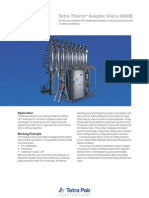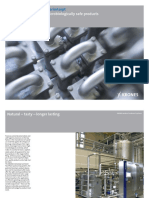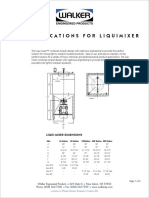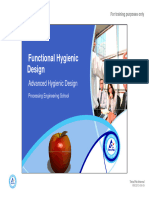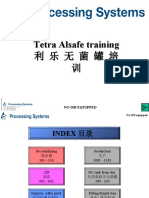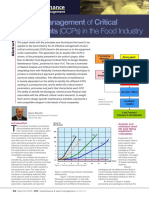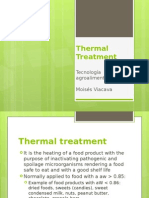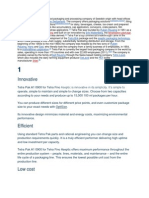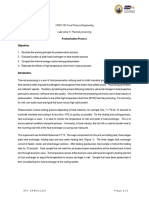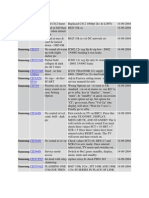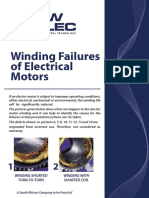Ultra-High Temperature (UHT) Sterilisation by Steam Infusion Objectives
Ultra-High Temperature (UHT) Sterilisation by Steam Infusion Objectives
Uploaded by
Aziemah AulanCopyright:
Available Formats
Ultra-High Temperature (UHT) Sterilisation by Steam Infusion Objectives
Ultra-High Temperature (UHT) Sterilisation by Steam Infusion Objectives
Uploaded by
Aziemah AulanOriginal Description:
Original Title
Copyright
Available Formats
Share this document
Did you find this document useful?
Is this content inappropriate?
Copyright:
Available Formats
Ultra-High Temperature (UHT) Sterilisation by Steam Infusion Objectives
Ultra-High Temperature (UHT) Sterilisation by Steam Infusion Objectives
Uploaded by
Aziemah AulanCopyright:
Available Formats
MICET
CFB20504 Food Process Engineering
Laboratory 2: Thermal Processing of Food
Ultra-High Temperature (UHT) Sterilisation by Steam Infusion
Objectives
1. Familiarise the boiler operation as energy supply for UHT equipment
2. Quantify the UHT process parameters
3. Analysing the effect of UHT on physical properties of food
Introduction
Thermal treatment is an approach to preserve food products. Pasteurisation is one technique of thermal treatment
which is widely being used to prolong the shelf life of food product. The aim of pasteurisation is to reduce the
microbial numbers to a safe level and not to kill it. Pasteurisation inactivate enzymes and kill relatively
heat-sensitive microorganisms that cause spoilage with minimal changes in food physicochemical properties. The
purpose of thermal treatment mostly relies on the pH of the food. For low-acid foods (i.e pH>4.5) pasteurisation is
for destruction of pathogenic bacteria. Other purposes of pasteurisation in relation to pH of food are given in
Table 1.
Table 1: Purpose for pasteurisation for different foods (Handbook of Food Preservation, 2 nd Edition)
SFI CFB20504 JAN18’ P a g e 1|7
MICET
Generally, to achieve desired pasteurisation conditions involves a combination of time and temperature such as
heating foods to relatively lower temperature at a longer time. Alternately, pasteurisation can be done through
higher temperature and shorter time. Test to evaluate effectiveness of pasteurisation process include colorimetric
tests, rapid enzymatic assay (Alkaline phosphatase, ALP) and determination of redox potential (in citrus juices).
Common type of pasteurisation are:
1. In-package pasteurisation- heating to sterility level is not required. Gradual change in temperature is
preferred in some containers.
2. Pasteurisation prior to packaging- preheating. Suitable for heat-sensitive foods.
3. Batch pasteurisation- low temperature short time process
4. Continuous pasteurisation- high-temperature-short-time (HTST) process
Ultra-High-Temperature Pasteurisers (UHT)
UHT pasteurisation takes place at ultra-high temperature as high as 131oC compared to the normal pasteurisation
that is achieved at 72oC for 15 seconds. In order to arrive at such a high temperature in short time, high temperature
and pressure steam is either injected or infused into the food mass. The food is then flashed in a vacuum vessel
such that the same amount of water as the amount of steam infused is removed. UHT treatment is desirable
because of its efficiency to reduce greater amount of microbial growth even its effects on ice-cream texture.
Although pasteurisation is a mild heat treatment, deterioration of pasteurised food is inevitable. Quality of
pasteurised foods may reduce in flavour, aroma and vitamins. Colour changes in juices and milk are not because
of pasteurisation but because of enzymatic browning or homogenisation. Figure 1 to Figure 3 are the schematics
for the UHT unit.
Materials and Equipment
1. Milk powder 5. UHT Pasteurisation unit
2. Water 6. Boiler
3. Tintometer
4. Viscometer
SFI CFB20504 JAN18’ P a g e 2|7
MICET
Procedures
A (Boiler operation)
1. Open the steam valve and all valves in the water feed line (ensure the feed water pump is primed).
2. Switch the door isolator to the ‘ON’ position.
3. Ensure the boiler selector and all tank elements are ‘ON’. Turn the feed water pump to the off position.
4. Open the boiler blowdown valve and lower the water level in the boiler until the low water alarm reset button
illuminated and triggered (sound).
5. Close the blowdown valve. Turn the feed water switch to ‘ON’. The feed water pump should start and restore
the water level to the normal position and stop.
6. Press the low water level reset button. The illuminating light should disappear and the audible alarm should
cease. Elements should re-energise. The elements selector switches should illuminate.
7. Boiler is now ready for use. The on/off steam pressure controller will control the on/off cycle of the elements
once the boiler is operating.
8. The low water relays, automatically maintain level of water in the boiler (and tank if fitted) and will immediately
shut off the power to the elements should the water level fall to an unsafe level.
9. The element switches situated on the control panel enable elements to be switched on/off independently to
meet steam requirements.
When the low water level alarm sounds, elements that are energised should de-energise and the element
selector switches should disappear.
B (UHT operation)
1. Ensure that all on/off valves are closed initially. Open valve (29) to allow compressed air to the pressure
regulating valve (20). Adjust the pressure on gauge (P4) until it reads 5 bar.
2. Feed tank (A) can accept a batch of 2.0 litres of process fluid. Start by using de-mineralised water so that the
running conditions can be approximated. Pour water into the feed tank after removing the filler plug. This plug
must not be removed if vessel is pressurised as indicated on pressure gauge (P1). Valve (16) is designed to
exhaust any pressure in (A) when moved to allow the plug to be lifted out. Make sure the plug is firmly replaced
before operating valve (16) to re-apply pressure. The air pressure on this vessel determines the throughput
rate and this is varied using hand wheel on regulating valve (22). The initial setting will be 1 bar above the
pressure required in the steam vessel (C).
3. Carefully open valve (28) which will admit steam to the pressure control valve (27). The steam pressure in
the vessel (C) determines the process temperature and valve (27) will be adjusted to suit requirements but this
can be set initially at 3 bar (gauge P2). Steam will enter the vessel (C), some will vent through orifice (K)
making hissing sound and the pressure will gradually rise to the adjusted value.
SFI CFB20504 JAN18’ P a g e 3|7
MICET
4. Open valve (2) using MANUAL SELECT button on the control console. Steam will pass through orifice (E) to
the vacuum chamber (F).
5. Open valve (19). Check the water is flowing into liquid ring vacuum pump and switch on the pump. Valve (19)
should be carefully adjusted to allow a reading of approximately 100mbar on gauge (P3). Carefully open
valve (8).
6. Set the process timers on the control console to:
HOLDING TIME- 0.40
PROCESS TIME- 010 sec
DRAIN TIME- 05.0
Close valve (2) before initiating cycle. Press the PROCESS START button to begin the process.
7. Samples are collected in vessel (F) and this can be disposed of by first closing vacuum valve (8) then open
valves (12) and (9) then open valve (3) and carefully (4)-the sample will pass through the cooling coil and out
through valve (4) to waste.
8. Close all on/off valves again except (19), (28) and (29). Release any pressure in (F) through the discharge
system valves (3) and (4) before opening valve (8) to reintroduce vacuum to vessel (F).
9. Using MANUAL SELECT switch open valve (2). This will push out any condensate that has collected in sight
glass (D) and steam will continue to push any condensate vacuum vessel (F). This is the STANDBY condition
and now it is possible to regulate the air flow rates. Ensure air pressure of valve (20) is reading approximately
2.0 bar above the process vessel pressure (P2). Open valves (13) and (15) then open valve (17), air will
pass through V13 and V15. Temperature will fall and fall steady. If temperature DECREASED during run,
open valve (18) slowly. Closed valve (17) sufficiently to return the temperature to its original value. Do the
opposite it the temperature INCREASED during run.
C (Analysis of sample)
1. Take a volume of sample and test for colour changes and viscosity.
SFI CFB20504 JAN18’ P a g e 4|7
MICET
Fig 1: UHT/ Aseptic unit
A- FEED CHAMBER J- PTFE FILTER
B- ATOMIZING NOZZLE K- ORIFICE PLATE
C- STEAM VESSEL L- STERILE AIR FILTER
D- SIGHT GLASS M- STERILE AIR FILTER
E- ORIFICE PLATE N- ELCB SWITCH
F- VACUUM CHAMBER P- PRESSURE GAUGE
G- COOLING COIL T-TYPE K THERMOCOUPLE
H- STEAM DRIER V- AIR FILTER
W- DRAIN VALVE NO 1-32: VALVES
SFI CFB20504 JAN18’ P a g e 5|7
MICET
Fig 2: UHT/ Aseptic unit
SFI CFB20504 JAN18’ P a g e 6|7
MICET
Fig 3: PID UHT/ Aseptic unit
Data Analysis and Questions
Using recorded data:
1. Determine the steam temperature used, heated temperature of products and holding time.
2. Compute the mass and energy balance for the process.
3. Evaluate and discuss the effects of thermal treatment onto the physical properties of sample.
4. Elaborate on the efficiency of boiler.
SFI CFB20504 JAN18’ P a g e 7|7
You might also like
- 100 Specifications c15 and c18 CaterpillarDocument292 pages100 Specifications c15 and c18 CaterpillarBASILIO JARA HUERTA100% (7)
- Cfx700 EcoDocument19 pagesCfx700 Eco6b98pgb4v8No ratings yet
- Frucor Case Study June 2010Document19 pagesFrucor Case Study June 2010Saravanan MathiNo ratings yet
- Tetra Plex C10-ECO: Plate Heat ExchangerDocument2 pagesTetra Plex C10-ECO: Plate Heat ExchangerĐình KiênNo ratings yet
- Troubleshooting Milk Flavor Problems - Dairy Cattle Nutrition - Penn State ExtensionDocument7 pagesTroubleshooting Milk Flavor Problems - Dairy Cattle Nutrition - Penn State ExtensionCostaEdvaldoNo ratings yet
- The Relationship Advantage Become A Trusted Advisor and Create Clients For Life PDFDocument288 pagesThe Relationship Advantage Become A Trusted Advisor and Create Clients For Life PDFABDELMALEK .TEBOUDANo ratings yet
- Tetra Therm Aseptic Visco SSHEDocument4 pagesTetra Therm Aseptic Visco SSHEsudheendracvkNo ratings yet
- Manual de Operacion y Mantenimiento UHTDocument16 pagesManual de Operacion y Mantenimiento UHTJuan Esteban Moreno VeraNo ratings yet
- Vitamin C Retention - White Paper RevisionDocument12 pagesVitamin C Retention - White Paper RevisionLeonardo SouzaNo ratings yet
- Sterilization and Ultra-High-Temperature ProcessingDocument15 pagesSterilization and Ultra-High-Temperature ProcessingNishkarsh AgarwalNo ratings yet
- Krones: Varioflash and VarioaseptDocument13 pagesKrones: Varioflash and VarioaseptHoa XaNo ratings yet
- Evaporation For Instant Coffee Plants Tcm11 54061Document1 pageEvaporation For Instant Coffee Plants Tcm11 54061Hung DoNo ratings yet
- 10.CPGSymposium GEADocument21 pages10.CPGSymposium GEAAhmet MetinNo ratings yet
- Tanques WalkerDocument2 pagesTanques WalkerAnonymous w4ZnisPlazNo ratings yet
- Tetra Pak Indirect UHT Unit PFF SSHE - PDDocument4 pagesTetra Pak Indirect UHT Unit PFF SSHE - PDLotfi JeffaliNo ratings yet
- 4 - 1 Functional Hygienic DesignDocument60 pages4 - 1 Functional Hygienic Designtaiduc167No ratings yet
- Alsafe TrainingDocument54 pagesAlsafe Trainingqiaohongzedingtalk.comNo ratings yet
- Hot Fill Versus Aseptic Versus Preservatives Hot Fill Versus Aseptic Versus PreservativesDocument26 pagesHot Fill Versus Aseptic Versus Preservatives Hot Fill Versus Aseptic Versus PreservativesLa Hoài NamNo ratings yet
- Istantanea Schermo 2021-01-20 (15.20.00)Document98 pagesIstantanea Schermo 2021-01-20 (15.20.00)6b98pgb4v8No ratings yet
- 000 Startup & AgendaDocument4 pages000 Startup & AgendaHoàng Minh ÁiNo ratings yet
- PD-leaflet Tetra Pak Aseptic TankDocument4 pagesPD-leaflet Tetra Pak Aseptic TankLinh VlogsNo ratings yet
- Cleaning in Place: Technical Training Centre 1/9902 Training Document. For Training Purpose OnlyDocument4 pagesCleaning in Place: Technical Training Centre 1/9902 Training Document. For Training Purpose OnlyMohamed SayedNo ratings yet
- D3-4 Tea Extractors - June 2013Document24 pagesD3-4 Tea Extractors - June 2013Angga SukmaNo ratings yet
- Understanding LethalityDocument13 pagesUnderstanding LethalityFrankPapaNo ratings yet
- Trouble Shooting in Yoghurt ProductionDocument12 pagesTrouble Shooting in Yoghurt ProductionSydney DodooNo ratings yet
- 05 PasteurisationDocument52 pages05 PasteurisationSadhan PadhiNo ratings yet
- HomogenizationDocument17 pagesHomogenizationTamizh TamizhNo ratings yet
- Process Technology For The: Fruit Juice and Primary IndustriesDocument16 pagesProcess Technology For The: Fruit Juice and Primary IndustriesSandi ApriandiNo ratings yet
- Homogenizing Valves Tcm11 50776Document8 pagesHomogenizing Valves Tcm11 50776Siddharth MohapatraNo ratings yet
- Effective Management of Critical Contro PDFDocument5 pagesEffective Management of Critical Contro PDFĐivềphía Mặt TrờiNo ratings yet
- 4 - 2 HRA Plant ExerciseDocument5 pages4 - 2 HRA Plant Exercisetaiduc167No ratings yet
- pd10196 Tetra Alsafe PDFDocument2 pagespd10196 Tetra Alsafe PDFEusebio NavarroNo ratings yet
- Tetra-Pak-7000-Litres-Aseptic-Tank-Vd-Buffering-Processing-Equipment 2Document2 pagesTetra-Pak-7000-Litres-Aseptic-Tank-Vd-Buffering-Processing-Equipment 2Frank valdezNo ratings yet
- RotothermDocument2 pagesRotothermLee HaagNo ratings yet
- Tetrapak - Partial HomogenizationDocument3 pagesTetrapak - Partial Homogenizationade100% (1)
- Tetra Spira Floc Tubular Heat ExchangerDocument4 pagesTetra Spira Floc Tubular Heat ExchangerFATKHURNo ratings yet
- Thermal Treatment: Tecnología Agroalimentaria I Moisés ViacavaDocument74 pagesThermal Treatment: Tecnología Agroalimentaria I Moisés ViacavaLuis EnriqueNo ratings yet
- Antonio RendinaDocument30 pagesAntonio RendinaPhan Trần Bá100% (3)
- ESA Instruction Manual English 1.01Document18 pagesESA Instruction Manual English 1.01Stephany Sucerquia100% (1)
- 5-Q5b-Training Handbook - Whey Every AspectDocument288 pages5-Q5b-Training Handbook - Whey Every AspectMinh HiếuNo ratings yet
- Day Two 2 CIP CleaningDocument58 pagesDay Two 2 CIP CleaningSupermobile 786No ratings yet
- Physical Properties and Microstructure of Yoghurt Enriched With MilkDocument56 pagesPhysical Properties and Microstructure of Yoghurt Enriched With MilkMai Nguyễn Trâm Anh100% (1)
- Selected Components For YouDocument17 pagesSelected Components For YouXuân Hòa NguyễnNo ratings yet
- Other Raw Materials June 2013Document93 pagesOther Raw Materials June 2013Angga SukmaNo ratings yet
- YoghurtDocument2 pagesYoghurtIngrid AlvesNo ratings yet
- TA General1Document78 pagesTA General1Xuân Hòa NguyễnNo ratings yet
- Aseptic Line Procedures Handbook PL01284 THP Rev0Document34 pagesAseptic Line Procedures Handbook PL01284 THP Rev0Thanh Loi LeNo ratings yet
- FDV Apv SW4 DN25-100 Atex UkDocument48 pagesFDV Apv SW4 DN25-100 Atex UkvipulsietNo ratings yet
- Tetra Pak Long Life Milk Campaign - FinalDocument2 pagesTetra Pak Long Life Milk Campaign - FinalTayyab RazaNo ratings yet
- Syrup Manufacturing Pepsi Plag RemoveDocument81 pagesSyrup Manufacturing Pepsi Plag RemoveHimanshu SharmaNo ratings yet
- 3 - 1 AHD 20130923 Cleaning TechnologyDocument131 pages3 - 1 AHD 20130923 Cleaning Technologytaiduc167No ratings yet
- Innovative: Åkerlund & Rausing Tetrahedron PackageDocument6 pagesInnovative: Åkerlund & Rausing Tetrahedron Packageravijangde10No ratings yet
- Steps of PasteurizationDocument2 pagesSteps of PasteurizationMichel AdamNo ratings yet
- Dairy Process TechnologyDocument28 pagesDairy Process TechnologyNrl Nbl RmlnNo ratings yet
- FS328 Doehler Carbonated-Softdrinks ColaDocument2 pagesFS328 Doehler Carbonated-Softdrinks ColaAbdalkaher AhmedNo ratings yet
- FDA Recommended Pasteurization TimeDocument2 pagesFDA Recommended Pasteurization TimeMarquel Audreyan0% (1)
- Manufacturing of Sweetened Condensed MilkDocument6 pagesManufacturing of Sweetened Condensed Milksree anugraphics100% (1)
- S01E01-Lars-Goran-Jenny Tetra Pak Best Practice PDFDocument10 pagesS01E01-Lars-Goran-Jenny Tetra Pak Best Practice PDFKhemiri WajdiNo ratings yet
- APV Membrane Systems For Multi Dairy ApplicationsDocument43 pagesAPV Membrane Systems For Multi Dairy ApplicationsRavi Chandran RNo ratings yet
- Advanced Dairy Science and TechnologyFrom EverandAdvanced Dairy Science and TechnologyTrevor BritzNo ratings yet
- Advances in Dairy ProductsFrom EverandAdvances in Dairy ProductsFrancesco ContoNo ratings yet
- Pasteurisation Process Objectives: CFB31103 Food Process Engineering Laboratory 4: Thermal ProcessingDocument3 pagesPasteurisation Process Objectives: CFB31103 Food Process Engineering Laboratory 4: Thermal Processingnurul nabilah bt khairul anuarNo ratings yet
- Cfb40503 Lab ManualDocument21 pagesCfb40503 Lab ManualAziemah AulanNo ratings yet
- PBL Report FullDocument12 pagesPBL Report FullAziemah AulanNo ratings yet
- Lab Manual Gas Pressure Process ControlDocument10 pagesLab Manual Gas Pressure Process ControlAziemah AulanNo ratings yet
- Particle Size Distribution (PSD) Objectives: CFB20504 Food Process Engineering Laboratory 1: Mechanical ReductionDocument5 pagesParticle Size Distribution (PSD) Objectives: CFB20504 Food Process Engineering Laboratory 1: Mechanical ReductionAziemah AulanNo ratings yet
- Lecturer's Name: Section/ Group/ Name: Date:: Lab Report: CLD 20502 Basic Engineering WorkshopDocument1 pageLecturer's Name: Section/ Group/ Name: Date:: Lab Report: CLD 20502 Basic Engineering WorkshopAziemah AulanNo ratings yet
- Assignment Fluid (Soalan)Document1 pageAssignment Fluid (Soalan)Aziemah AulanNo ratings yet
- TOEIC® Test Speaking Questions 1 - 2: Quick GuideDocument45 pagesTOEIC® Test Speaking Questions 1 - 2: Quick GuideNam PhanNo ratings yet
- Principles of Safety Hygiene & Sanitation: (Sangene)Document42 pagesPrinciples of Safety Hygiene & Sanitation: (Sangene)gregNo ratings yet
- PAK MASTER 50 Plasma Cutter ManualDocument73 pagesPAK MASTER 50 Plasma Cutter ManualmedkvNo ratings yet
- Amar Tea EmergencyDocument6 pagesAmar Tea EmergencySyed Raja AliNo ratings yet
- Agrarian Position Paper PrelimDocument21 pagesAgrarian Position Paper PrelimNyl Aner0% (1)
- Timer Soutput: Tm-619-SeriesDocument2 pagesTimer Soutput: Tm-619-SeriesubiNo ratings yet
- App of Boolean AlgebraDocument11 pagesApp of Boolean AlgebraGiriNo ratings yet
- Iii. Style in Technical Communication Iii. Style in Technical CommunicationDocument29 pagesIii. Style in Technical Communication Iii. Style in Technical CommunicationMartial D. TeachNo ratings yet
- Domino A Series User Guide English PDFDocument42 pagesDomino A Series User Guide English PDFprusikNo ratings yet
- Jullianne's Catering and Events ServicesDocument16 pagesJullianne's Catering and Events Servicesmaria alpha sierra abiertasNo ratings yet
- HRW Hpe8884p1 v4 Manual 100908Document21 pagesHRW Hpe8884p1 v4 Manual 100908game kuNo ratings yet
- Tellabs 8600 Sys OverviewDocument4 pagesTellabs 8600 Sys OverviewkanfouchNo ratings yet
- Samsung 2Document21 pagesSamsung 2Jessie Codilla LebitaNo ratings yet
- Raunak Kumar ResumeDocument2 pagesRaunak Kumar Resumeraunak29No ratings yet
- A64 HD R 60 Datasheet PDFDocument8 pagesA64 HD R 60 Datasheet PDFCruzado Vilca AmesquitaNo ratings yet
- Ais Final QuizDocument5 pagesAis Final QuizClaudette ClementeNo ratings yet
- Services Rendered by Banks.: Advancing of LoansDocument3 pagesServices Rendered by Banks.: Advancing of LoansKulgeet TanyaNo ratings yet
- 2010 Nova Parts Catalog 62 67Document155 pages2010 Nova Parts Catalog 62 67Jonah RagleNo ratings yet
- Queue TreeDocument10 pagesQueue TreeayeemhanNo ratings yet
- Winding Failures of Electrical Motors: Winding Shorted Turn-To-Turn Winding With Shorted CoilDocument4 pagesWinding Failures of Electrical Motors: Winding Shorted Turn-To-Turn Winding With Shorted Coilalexmontell100% (2)
- G.R. No. 97471 People vs. PunoDocument7 pagesG.R. No. 97471 People vs. PunoMichelle Montenegro - AraujoNo ratings yet
- Combine Harvester: Instruction BookDocument220 pagesCombine Harvester: Instruction BookMichael DavenportNo ratings yet
- NozzlesDocument5 pagesNozzlessreelu100% (1)
- Formal Language and Automata Theory: UNIT-1Document38 pagesFormal Language and Automata Theory: UNIT-1Venkata Rao SNo ratings yet
- PBA V Court of AppealsDocument9 pagesPBA V Court of AppealsRizza MoradaNo ratings yet
- Cementitious Materials-Nine Millennia and A New CenturyDocument21 pagesCementitious Materials-Nine Millennia and A New Centuryatiachaimaa.acNo ratings yet
- European CV Cover Letter Template BlackDocument2 pagesEuropean CV Cover Letter Template BlackRahaya TayyabNo ratings yet
- RM Final Card SamiraDocument9 pagesRM Final Card SamiraYasser MahamoudNo ratings yet






